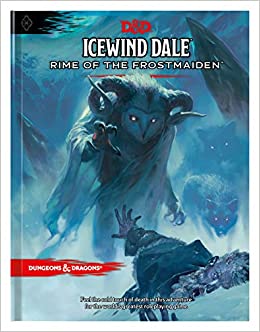Aye fair adventurer, have ye heard the tale of Fannie Quigley of Knollwood, she who has a +5 to attack bonus, advantage on her survival rolls, and makes a scrumptious blueberry pie?
No? Never heard of her?
That’s actually understandable because Knollwood is the D&D campaign setting I made up 15 seconds ago, inspired by one of those guys who was wearing a D&D t-shirt while he was chilling outside the Jimmy John’s across from the Knollwood Mall. Also, it’s clear that he doesn’t do much of anything else during the day.
My point is this: since the very dawn of D&D, people have been creating custom homebrew campaign settings. And even when players aren’t worldbuilding from scratch, they look to alternative published campaign settings like Eberron, because Fannie Quigley of Knollwood just needs to spread her wings, by gosh, as she feels a little cramped just adventuring around The Forgotten Realms.
But there is also something wonderful about the Forgotten Realms – shared lore. The enduring strength of D&D as always been that its limited only by imagination. And that has given rise to endless settings, many published, but most thunk up by dungeon masters for their home games.
Yet any strength can become a weakness. While there has been decades of D&D played in endless ways in basements everywhere, there hasn’t been much in common to share.
Outside of Drizzt, there is little shared lore in D&D, unlike something like the Marvel Universe where fans have decades of shared characters to nerd out about around ye ol’ water cooler.
The Forgotten Realms is the closest thing D&D has to an “official” setting and provides the best opportunity to establish shared lore. That’s one reason why I think it is brilliant that Icewind Dale: Rime of the Frostmaiden is an adventure book that doubles as a campaign setting.
As I read through Icewind dale: Rime of the Frostmaiden, I was struck by how much it read not just like a wide-open adventure, but also by how much it read as a campaign setting book. Consider this:

Icewind Dale is in the Forgotten Realms, yet the climate gives it a wholly different feel than most of the setting. Rime of the Frostmaiden did an excellent job of painting Icewind Dale as ‘the other,” as an environment within the Forgotten Realms, yet totally different than any existing story that came before..
Icewind Dale is a land that ‘sits atop’ The Forgotten Realms. As a result, it would be very easy to make it feel just like everywhere else, only with less Vitamin D due to a lack of sunlight.
Rime of the Frostmaiden doesn’t read that way at all. There is a uniqueness to the setting. Not only do you have unique and interesting creatures, but there is a special flavor to them. What’s more, The Thing vibe gives it a foreboding, isolated tone that further differentiates it as not of the Forgotten Realms, although it is set in the Forgotten Realms.
Rime of the Frostmaiden details numerous cities and locations. Ten, in fact. Just like in real estate, location, location, location provides much of the value in a campaign setting book. And Rime of the Frostmaiden does a wonderful job of detailing Ten Towns, the 10 small settlements that cluster together to form the geographic focus of Icewind Dale.
And the ten towns aren’t glossed over. They comprise the first 100 pages of the book. Then the next 70 pages zoom out and details the greater area beyond Ten Towns.
In other words, there is ample background, maps, and story hooks for Dungeon Masters to create separate campaigns centered on the individual locations in Icewind Dale.
The mechanics or travel and survival are covered as well. Rime of the Frostmaiden doesn’t just cover locations, it covers the space between as well. The book contains enough crunch and specific rules that a DM could run her own adventure centered there and feel like she has been given rules support specific to the locale. Wondering how player characters would forage for food, move around, or make a living? Well, wonder no more, because Rime of the Frostmaiden tells you.
There are dozens of NPCs and creatures. Creatures are in many ways the overall strength of Rime of the Frostmaiden as they are unique, interesting, and logical to the locale. They make sense in place.
Icewind Dale: Rime of the Frostmaiden is an excellent adventure, but it is more. It’s a setting book that is presented so well that player’s will love it there, so it understandable that they may want more after the book’s adventure wraps. The book absolutely provides an opportunity for that.
I really love what the developer’s have done with the Forgotten Realms books for D&D 5e. First, Out of the Abyss introduced players to the Underdark, an area in the Forgotten Realms, yet quite unlike anything else.
We were also given an adventure in Waterdeep, but the book had depth enough that adventures could be created for virtually any city-based setting. We saw the same in the jungles of Chult. Sure, it’s in the Forgotten Realms yet the book gave us more.
There are more examples and adding them up points to the fact that WotC has supported the Forgotten Realms really well, giving players an opportunity to create shared lore.
What’s more, they’ve given support to areas that offer players a wholly different vibe. Fannie Quigley of Knollwood could be a character in Icewind Dale, in the Underdark, or in Chult, and it would be an entirely different character.

